Sydney Campus MA506 Business & Company Law: Partnership Act Analysis
VerifiedAdded on 2020/03/23
|10
|2222
|169
Report
AI Summary
This individual assignment, completed for the MA506 Business & Company Law course, analyzes the potential liabilities of Violet and Sonny concerning a loan taken by Busy Bee Florist Shop from Friendly Bank. The report delves into the Partnership Act 1892 (NSW), examining the elements required to establish a partnership, including the carrying on of business, in common, for profit. It references key legal precedents such as Smith v Anderson, Canny Gabriel Castle Advertising v Volume Sales, Wiltshire v Kuenzli, Stekel v Ellice, Exparte Coral Investments Pty Ltd, Television Broadcasters Ltd v Ashtons, Cox v Hickman, Re Ruddock, and Badeley v Consolidated Bank. The analysis assesses whether Violet and Sonny meet the criteria to be considered partners, thus determining their liability for the loan. The report concludes that Violet is likely a partner and liable, while Sonny is not considered a partner and is therefore not liable. The assignment provides a comprehensive overview of partnership law and its application in a business context.
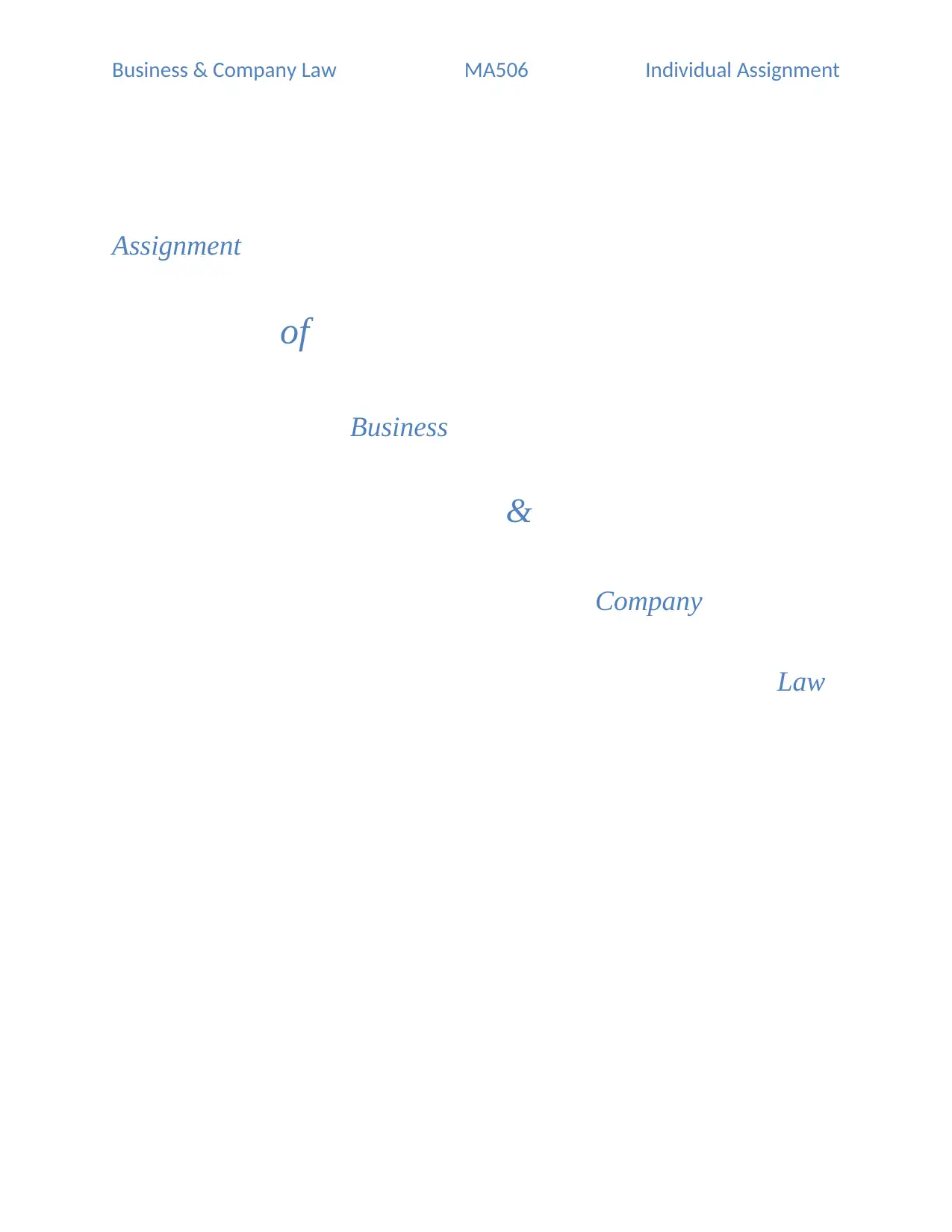
Business & Company Law MA506 Individual Assignment
Assignment
of
Business
&
Company
Law
Assignment
of
Business
&
Company
Law
Paraphrase This Document
Need a fresh take? Get an instant paraphrase of this document with our AI Paraphraser

Business & Company Law MA506 Individual Assignment
Assignment Cover Sheet
Student Id Number’s Student Surname’s Given name’s
Course:- Masters of Professional accounting
Unit Code- MA506 Due date-06th Oct Submitted-29th Sept
Unit Title-Business & Company Law Individual Assignment
Tutor- Carlo Soliman Campus- Sydney
Assignment Cover Sheet
Student Id Number’s Student Surname’s Given name’s
Course:- Masters of Professional accounting
Unit Code- MA506 Due date-06th Oct Submitted-29th Sept
Unit Title-Business & Company Law Individual Assignment
Tutor- Carlo Soliman Campus- Sydney
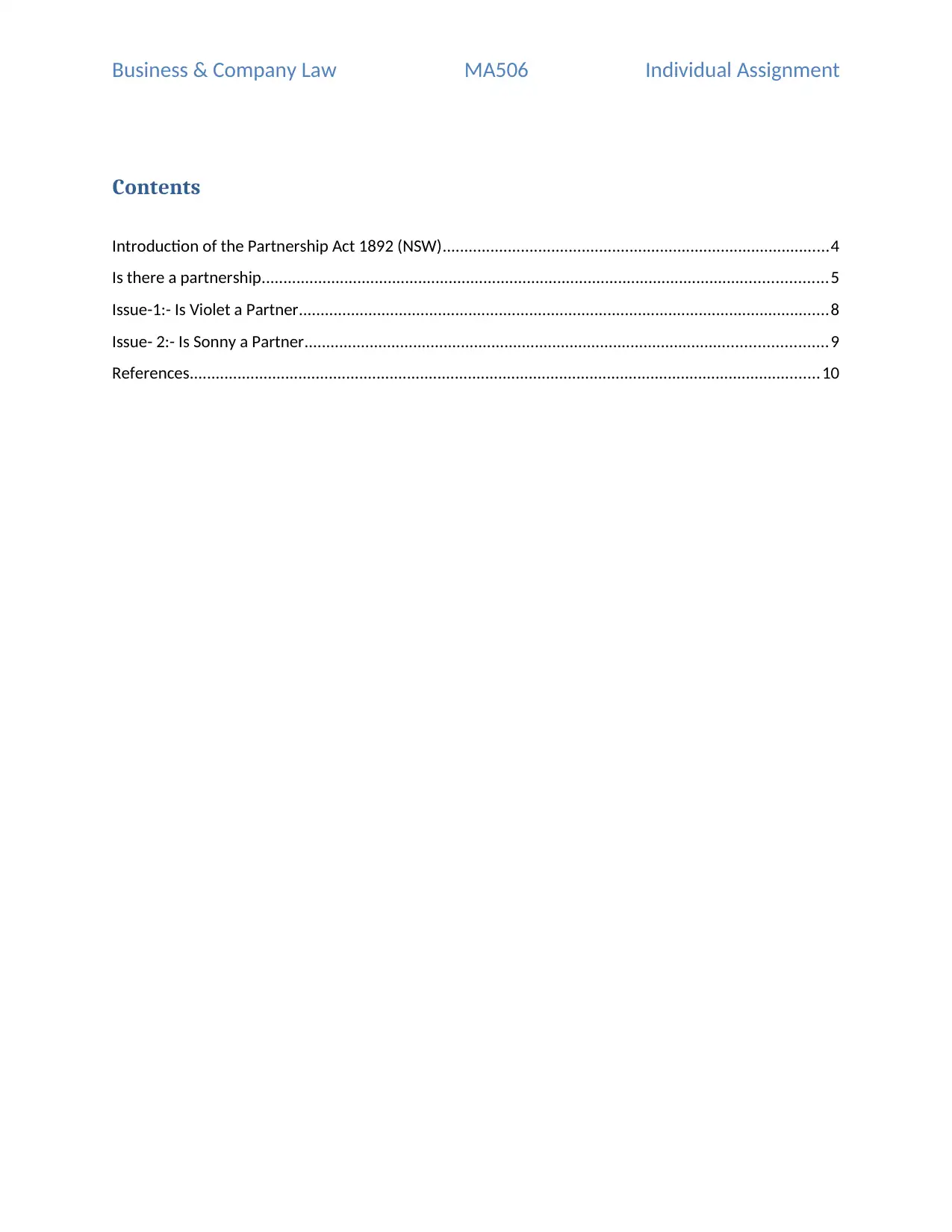
Business & Company Law MA506 Individual Assignment
Contents
Introduction of the Partnership Act 1892 (NSW).........................................................................................4
Is there a partnership..................................................................................................................................5
Issue-1:- Is Violet a Partner..........................................................................................................................8
Issue- 2:- Is Sonny a Partner........................................................................................................................9
References.................................................................................................................................................10
Contents
Introduction of the Partnership Act 1892 (NSW).........................................................................................4
Is there a partnership..................................................................................................................................5
Issue-1:- Is Violet a Partner..........................................................................................................................8
Issue- 2:- Is Sonny a Partner........................................................................................................................9
References.................................................................................................................................................10
⊘ This is a preview!⊘
Do you want full access?
Subscribe today to unlock all pages.

Trusted by 1+ million students worldwide

Business & Company Law MA506 Individual Assignment
Advise for Violet and Sonny
In this case, the question that needs to be decided is related with the possible liability of Violet
and Sonny regarding the loan taken by Busy Bee Florist Shop from Friendly Bank. For this
purpose, it needs to be seen if both of them can be treated as the partners in the business and as a
result, liable to Friendly Bank for the loan.
Introduction of the Partnership Act 1892 (NSW)
In other to deal with this issue, section 1 of the Partnership Act (Vic) needs to be considered. In
this section, it has been provided that the presence of the elements have to be checked in order to
believe that about which it is present between the parties. Therefore, for this purpose. It needs to
be seen if there is (i) the carrying on of the business by the parties, (ii) carrying on the business
in common (iii) and all purpose of making profit by the parties. On the other hand, even if a
single element that does not exist, the law of partnership provides that such relationship cannot
be considered a partnership. In order to decide the meaning of the term 'carrying on business', the
issue is if there is a repetitiveness of action required or if even a one-off action by the parties is
sufficient. However the courts have laid stress on the fact that there should be a reputation or a
continuity of action. For example, in a given case, there was a group of depositors. They have
subscribed to purchase the shares in various submarine cable companies. Later on, the trustees
sold these shares to the investors. They also provided them with certificates. The issue that was
present before the court in this case was if the test can be described as a partnership (Smith v
Anderson, 1880).
Advise for Violet and Sonny
In this case, the question that needs to be decided is related with the possible liability of Violet
and Sonny regarding the loan taken by Busy Bee Florist Shop from Friendly Bank. For this
purpose, it needs to be seen if both of them can be treated as the partners in the business and as a
result, liable to Friendly Bank for the loan.
Introduction of the Partnership Act 1892 (NSW)
In other to deal with this issue, section 1 of the Partnership Act (Vic) needs to be considered. In
this section, it has been provided that the presence of the elements have to be checked in order to
believe that about which it is present between the parties. Therefore, for this purpose. It needs to
be seen if there is (i) the carrying on of the business by the parties, (ii) carrying on the business
in common (iii) and all purpose of making profit by the parties. On the other hand, even if a
single element that does not exist, the law of partnership provides that such relationship cannot
be considered a partnership. In order to decide the meaning of the term 'carrying on business', the
issue is if there is a repetitiveness of action required or if even a one-off action by the parties is
sufficient. However the courts have laid stress on the fact that there should be a reputation or a
continuity of action. For example, in a given case, there was a group of depositors. They have
subscribed to purchase the shares in various submarine cable companies. Later on, the trustees
sold these shares to the investors. They also provided them with certificates. The issue that was
present before the court in this case was if the test can be described as a partnership (Smith v
Anderson, 1880).
Paraphrase This Document
Need a fresh take? Get an instant paraphrase of this document with our AI Paraphraser
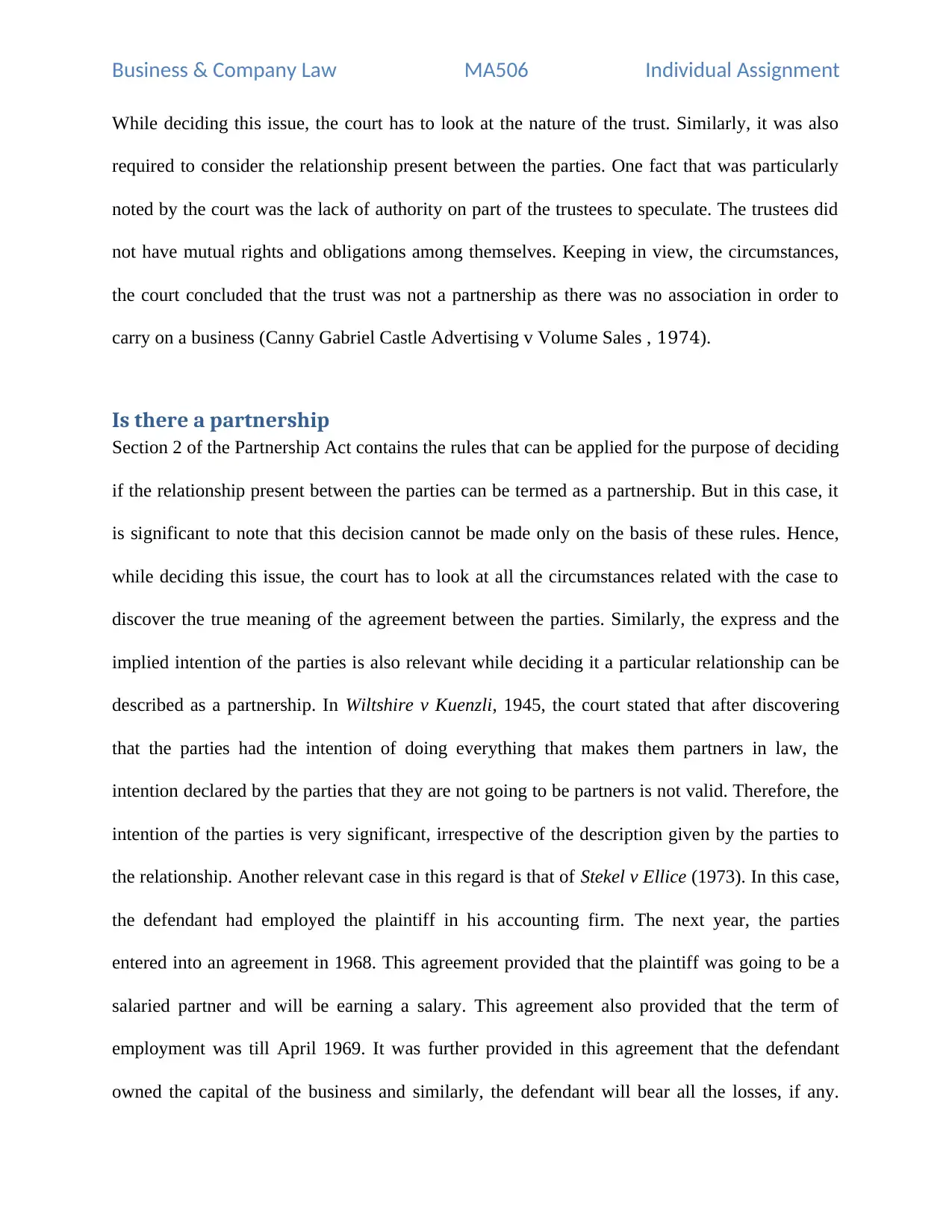
Business & Company Law MA506 Individual Assignment
While deciding this issue, the court has to look at the nature of the trust. Similarly, it was also
required to consider the relationship present between the parties. One fact that was particularly
noted by the court was the lack of authority on part of the trustees to speculate. The trustees did
not have mutual rights and obligations among themselves. Keeping in view, the circumstances,
the court concluded that the trust was not a partnership as there was no association in order to
carry on a business (Canny Gabriel Castle Advertising v Volume Sales , 1974).
Is there a partnership
Section 2 of the Partnership Act contains the rules that can be applied for the purpose of deciding
if the relationship present between the parties can be termed as a partnership. But in this case, it
is significant to note that this decision cannot be made only on the basis of these rules. Hence,
while deciding this issue, the court has to look at all the circumstances related with the case to
discover the true meaning of the agreement between the parties. Similarly, the express and the
implied intention of the parties is also relevant while deciding it a particular relationship can be
described as a partnership. In Wiltshire v Kuenzli, 1945, the court stated that after discovering
that the parties had the intention of doing everything that makes them partners in law, the
intention declared by the parties that they are not going to be partners is not valid. Therefore, the
intention of the parties is very significant, irrespective of the description given by the parties to
the relationship. Another relevant case in this regard is that of Stekel v Ellice (1973). In this case,
the defendant had employed the plaintiff in his accounting firm. The next year, the parties
entered into an agreement in 1968. This agreement provided that the plaintiff was going to be a
salaried partner and will be earning a salary. This agreement also provided that the term of
employment was till April 1969. It was further provided in this agreement that the defendant
owned the capital of the business and similarly, the defendant will bear all the losses, if any.
While deciding this issue, the court has to look at the nature of the trust. Similarly, it was also
required to consider the relationship present between the parties. One fact that was particularly
noted by the court was the lack of authority on part of the trustees to speculate. The trustees did
not have mutual rights and obligations among themselves. Keeping in view, the circumstances,
the court concluded that the trust was not a partnership as there was no association in order to
carry on a business (Canny Gabriel Castle Advertising v Volume Sales , 1974).
Is there a partnership
Section 2 of the Partnership Act contains the rules that can be applied for the purpose of deciding
if the relationship present between the parties can be termed as a partnership. But in this case, it
is significant to note that this decision cannot be made only on the basis of these rules. Hence,
while deciding this issue, the court has to look at all the circumstances related with the case to
discover the true meaning of the agreement between the parties. Similarly, the express and the
implied intention of the parties is also relevant while deciding it a particular relationship can be
described as a partnership. In Wiltshire v Kuenzli, 1945, the court stated that after discovering
that the parties had the intention of doing everything that makes them partners in law, the
intention declared by the parties that they are not going to be partners is not valid. Therefore, the
intention of the parties is very significant, irrespective of the description given by the parties to
the relationship. Another relevant case in this regard is that of Stekel v Ellice (1973). In this case,
the defendant had employed the plaintiff in his accounting firm. The next year, the parties
entered into an agreement in 1968. This agreement provided that the plaintiff was going to be a
salaried partner and will be earning a salary. This agreement also provided that the term of
employment was till April 1969. It was further provided in this agreement that the defendant
owned the capital of the business and similarly, the defendant will bear all the losses, if any.
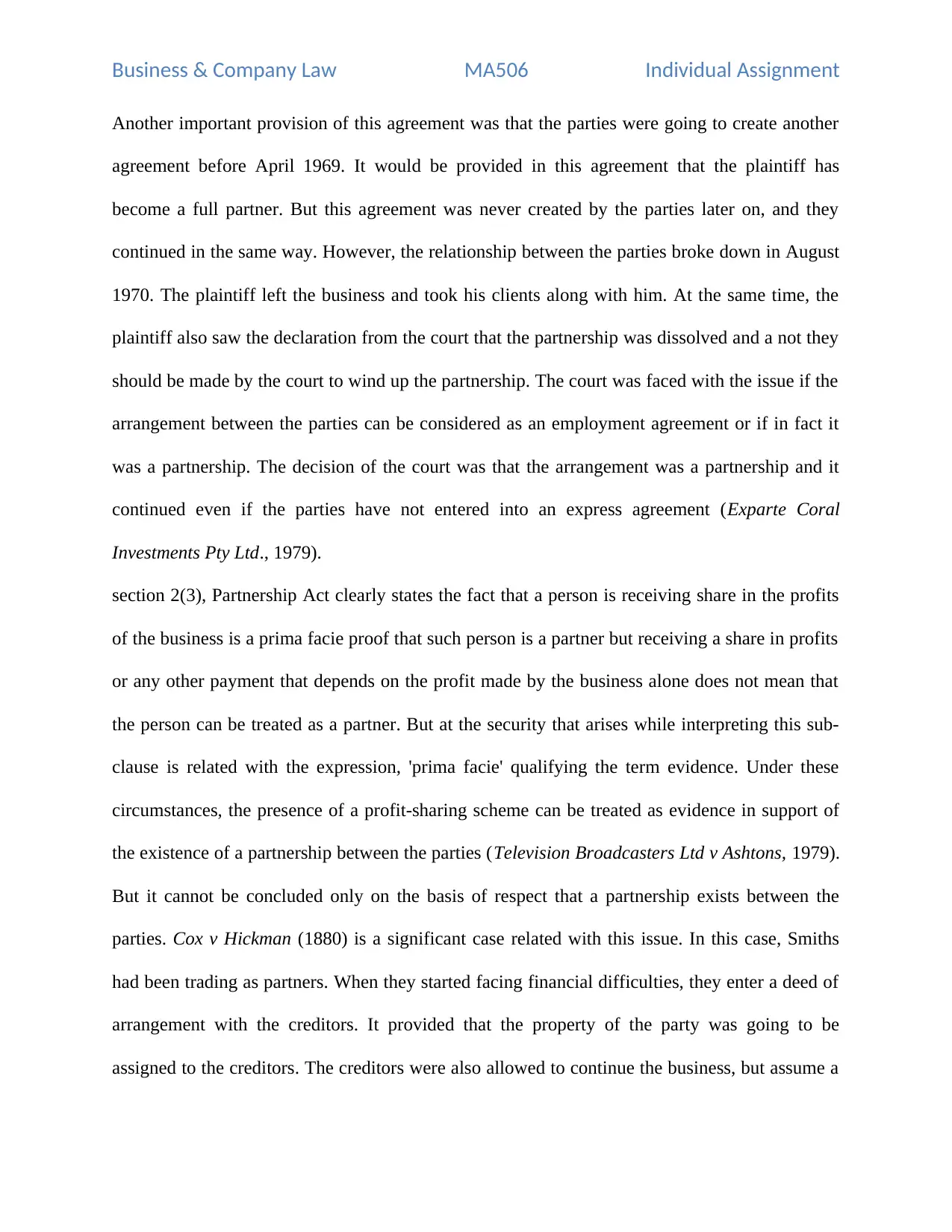
Business & Company Law MA506 Individual Assignment
Another important provision of this agreement was that the parties were going to create another
agreement before April 1969. It would be provided in this agreement that the plaintiff has
become a full partner. But this agreement was never created by the parties later on, and they
continued in the same way. However, the relationship between the parties broke down in August
1970. The plaintiff left the business and took his clients along with him. At the same time, the
plaintiff also saw the declaration from the court that the partnership was dissolved and a not they
should be made by the court to wind up the partnership. The court was faced with the issue if the
arrangement between the parties can be considered as an employment agreement or if in fact it
was a partnership. The decision of the court was that the arrangement was a partnership and it
continued even if the parties have not entered into an express agreement (Exparte Coral
Investments Pty Ltd., 1979).
section 2(3), Partnership Act clearly states the fact that a person is receiving share in the profits
of the business is a prima facie proof that such person is a partner but receiving a share in profits
or any other payment that depends on the profit made by the business alone does not mean that
the person can be treated as a partner. But at the security that arises while interpreting this sub-
clause is related with the expression, 'prima facie' qualifying the term evidence. Under these
circumstances, the presence of a profit-sharing scheme can be treated as evidence in support of
the existence of a partnership between the parties (Television Broadcasters Ltd v Ashtons, 1979).
But it cannot be concluded only on the basis of respect that a partnership exists between the
parties. Cox v Hickman (1880) is a significant case related with this issue. In this case, Smiths
had been trading as partners. When they started facing financial difficulties, they enter a deed of
arrangement with the creditors. It provided that the property of the party was going to be
assigned to the creditors. The creditors were also allowed to continue the business, but assume a
Another important provision of this agreement was that the parties were going to create another
agreement before April 1969. It would be provided in this agreement that the plaintiff has
become a full partner. But this agreement was never created by the parties later on, and they
continued in the same way. However, the relationship between the parties broke down in August
1970. The plaintiff left the business and took his clients along with him. At the same time, the
plaintiff also saw the declaration from the court that the partnership was dissolved and a not they
should be made by the court to wind up the partnership. The court was faced with the issue if the
arrangement between the parties can be considered as an employment agreement or if in fact it
was a partnership. The decision of the court was that the arrangement was a partnership and it
continued even if the parties have not entered into an express agreement (Exparte Coral
Investments Pty Ltd., 1979).
section 2(3), Partnership Act clearly states the fact that a person is receiving share in the profits
of the business is a prima facie proof that such person is a partner but receiving a share in profits
or any other payment that depends on the profit made by the business alone does not mean that
the person can be treated as a partner. But at the security that arises while interpreting this sub-
clause is related with the expression, 'prima facie' qualifying the term evidence. Under these
circumstances, the presence of a profit-sharing scheme can be treated as evidence in support of
the existence of a partnership between the parties (Television Broadcasters Ltd v Ashtons, 1979).
But it cannot be concluded only on the basis of respect that a partnership exists between the
parties. Cox v Hickman (1880) is a significant case related with this issue. In this case, Smiths
had been trading as partners. When they started facing financial difficulties, they enter a deed of
arrangement with the creditors. It provided that the property of the party was going to be
assigned to the creditors. The creditors were also allowed to continue the business, but assume a
⊘ This is a preview!⊘
Do you want full access?
Subscribe today to unlock all pages.

Trusted by 1+ million students worldwide

Business & Company Law MA506 Individual Assignment
new name for it.. The creditors were also allowed to divide the future income generated by the
business. It was also stated in the agreement that when the creditors have been repaid in full, the
business was going to be returned to the Smiths. Fox and Wheatcroft were the two creditors who
have been appointed as trustees. However Cox did not assume the role of a trusty and similarly,
Wheatcroft also remained a trustee only for a short time. When Wheatcroft stopped acting as a
trustee, the other trustees incurred debts to Hickman. Some bills of exchange, drawn on the
partnership were also given to him. Under these circumstances, Hickman wanted that Cox and
Wheatcroft should be held liable for these. However, the court concluded that these two were not
held as partners. The same way, there was no knowledge present on the part of Hickman
concerning the deed of arrangement. As a result, Cox and Wheatcroft were allowed to deny their
liability, although the arrangement provided that they can take a share in the profits. According
to the court only this fact was not sufficient to claim that they were partners.
Under these circumstances, the court arrived at the conclusion that the person sharing the net
profits can be described as a partner but this rule does not apply in all the cases. At this point, it
may be considered the sense in which the term 'sharing the profits' is used. In the present case,
the court had expressed his doubts if the creditors can be treated as sharing the profits because
they were only receiving the payment of their debt and were being paid exactly the same amount
of debt out of the profits made by the business. In the present case, the property owned by the
business was assigned to the trustees. So that they may carry on the business and the net profits
earned by the business were going to be divided among all its creditors and not only among the
creditors, who was signed with the deed, until the full repayment of the debt and if by receiving a
rate-able proportion out of the profit made by the business, and can be treated as partners. The
court expressed its opinion that this was not the case.
new name for it.. The creditors were also allowed to divide the future income generated by the
business. It was also stated in the agreement that when the creditors have been repaid in full, the
business was going to be returned to the Smiths. Fox and Wheatcroft were the two creditors who
have been appointed as trustees. However Cox did not assume the role of a trusty and similarly,
Wheatcroft also remained a trustee only for a short time. When Wheatcroft stopped acting as a
trustee, the other trustees incurred debts to Hickman. Some bills of exchange, drawn on the
partnership were also given to him. Under these circumstances, Hickman wanted that Cox and
Wheatcroft should be held liable for these. However, the court concluded that these two were not
held as partners. The same way, there was no knowledge present on the part of Hickman
concerning the deed of arrangement. As a result, Cox and Wheatcroft were allowed to deny their
liability, although the arrangement provided that they can take a share in the profits. According
to the court only this fact was not sufficient to claim that they were partners.
Under these circumstances, the court arrived at the conclusion that the person sharing the net
profits can be described as a partner but this rule does not apply in all the cases. At this point, it
may be considered the sense in which the term 'sharing the profits' is used. In the present case,
the court had expressed his doubts if the creditors can be treated as sharing the profits because
they were only receiving the payment of their debt and were being paid exactly the same amount
of debt out of the profits made by the business. In the present case, the property owned by the
business was assigned to the trustees. So that they may carry on the business and the net profits
earned by the business were going to be divided among all its creditors and not only among the
creditors, who was signed with the deed, until the full repayment of the debt and if by receiving a
rate-able proportion out of the profit made by the business, and can be treated as partners. The
court expressed its opinion that this was not the case.
Paraphrase This Document
Need a fresh take? Get an instant paraphrase of this document with our AI Paraphraser

Business & Company Law MA506 Individual Assignment
It has been provided by section 2(3) that the receipt of a debt at the liquidity demand made by a
person out of the profits earned by the business does not in itself make such a person partner.
This legal rule has been derived from the judgment made in Cox v Hickman (1860). But at the
same time, there's also been provided by the law that under certain circumstances, when it
becomes clear that the relationship was in reality a partnership, the lender can be considered a
partner regardless of the intention stated by the parties (Re Ruddock, 1879).
Another case that can be described as an example is Badeley v Consolidated Bank (1888). The
brief facts of this case are that the lender (the plaintiff) gave money to the borrower and security
over the plant belonging to the borrower. At the same time, it was agreed that the lender will
receive interest, as well as a share from the net profits of the business. The parties also agreed
that the amount of loan will be applied in order to carry out the work concerning the business. In
the same way, the lender has also been given the right to enter the property if the borrower
becomes bankrupt. While deciding the case, the Court of Appeal discovered the need to find the
'real agreement' that has been entered into by the parties. Therefore the court was of the opinion
that only the fact of sharing the profit is not sufficient for including a partnership. Therefore, in
this case, the court expressed opinion that the formal document executed by the parties expressed
the real truth. Therefore, the agreement was described as a contract of loan upon security. The
court also noted the fact that the lender was not going to take part the loss, if any suffered by the
business.
Issue-1:- Is Violet a Partner
After going through the relevant rules of law and the provisions of the partnership, it can be set
in the present case that Violet is liable to Friendly Bank regarding the loan because she can be
considered as a partner in Busy Bee florist shop.
It has been provided by section 2(3) that the receipt of a debt at the liquidity demand made by a
person out of the profits earned by the business does not in itself make such a person partner.
This legal rule has been derived from the judgment made in Cox v Hickman (1860). But at the
same time, there's also been provided by the law that under certain circumstances, when it
becomes clear that the relationship was in reality a partnership, the lender can be considered a
partner regardless of the intention stated by the parties (Re Ruddock, 1879).
Another case that can be described as an example is Badeley v Consolidated Bank (1888). The
brief facts of this case are that the lender (the plaintiff) gave money to the borrower and security
over the plant belonging to the borrower. At the same time, it was agreed that the lender will
receive interest, as well as a share from the net profits of the business. The parties also agreed
that the amount of loan will be applied in order to carry out the work concerning the business. In
the same way, the lender has also been given the right to enter the property if the borrower
becomes bankrupt. While deciding the case, the Court of Appeal discovered the need to find the
'real agreement' that has been entered into by the parties. Therefore the court was of the opinion
that only the fact of sharing the profit is not sufficient for including a partnership. Therefore, in
this case, the court expressed opinion that the formal document executed by the parties expressed
the real truth. Therefore, the agreement was described as a contract of loan upon security. The
court also noted the fact that the lender was not going to take part the loss, if any suffered by the
business.
Issue-1:- Is Violet a Partner
After going through the relevant rules of law and the provisions of the partnership, it can be set
in the present case that Violet is liable to Friendly Bank regarding the loan because she can be
considered as a partner in Busy Bee florist shop.
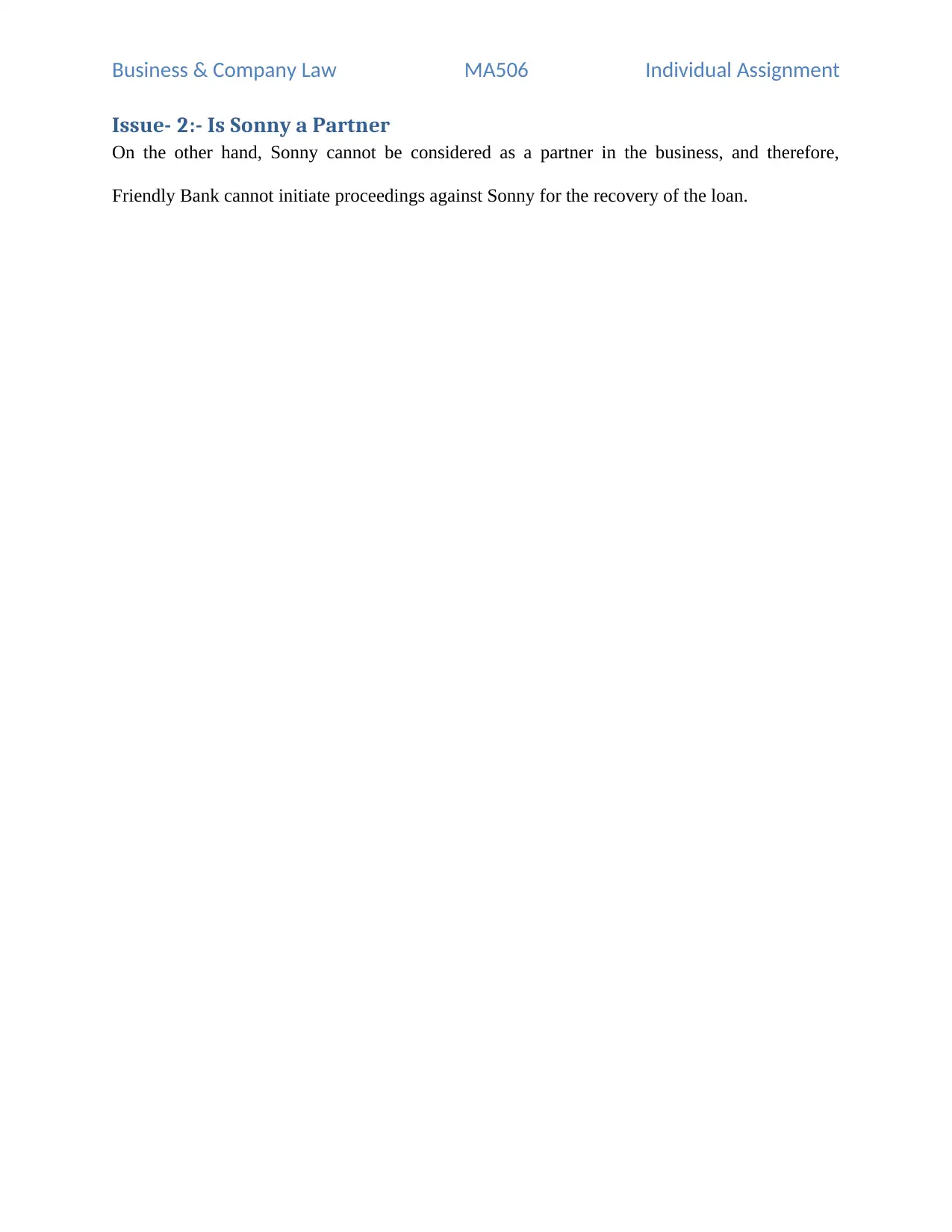
Business & Company Law MA506 Individual Assignment
Issue- 2:- Is Sonny a Partner
On the other hand, Sonny cannot be considered as a partner in the business, and therefore,
Friendly Bank cannot initiate proceedings against Sonny for the recovery of the loan.
Issue- 2:- Is Sonny a Partner
On the other hand, Sonny cannot be considered as a partner in the business, and therefore,
Friendly Bank cannot initiate proceedings against Sonny for the recovery of the loan.
⊘ This is a preview!⊘
Do you want full access?
Subscribe today to unlock all pages.

Trusted by 1+ million students worldwide

Business & Company Law MA506 Individual Assignment
References
Badeley v Consolidated Bank (1888) 38 Ch D 238
Canny Gabriel Castle Advertising Pty Ltd & Anor v Volume Sales (Finance) Pty Ltd (1974) 131
CLR 321
Cox v Hickman (1880) 8 HL Cas 268
Exparte Coral Investments Pty Ltd [1979] Qd R 292
Re Ruddock (1879) 5 VLR 51 (IP & M) 51
Smith v Anderson (1880) 15 Ch D 247
Stekel v Ellice [1973] 1 WLR 191
Television Broadcasters Ltd v Ashtons Nominees Pty Ltd (No 1) (1979) 22 SASR 552
Wiltshire v Kuenzli (1945) 63 WN 47
References
Badeley v Consolidated Bank (1888) 38 Ch D 238
Canny Gabriel Castle Advertising Pty Ltd & Anor v Volume Sales (Finance) Pty Ltd (1974) 131
CLR 321
Cox v Hickman (1880) 8 HL Cas 268
Exparte Coral Investments Pty Ltd [1979] Qd R 292
Re Ruddock (1879) 5 VLR 51 (IP & M) 51
Smith v Anderson (1880) 15 Ch D 247
Stekel v Ellice [1973] 1 WLR 191
Television Broadcasters Ltd v Ashtons Nominees Pty Ltd (No 1) (1979) 22 SASR 552
Wiltshire v Kuenzli (1945) 63 WN 47
1 out of 10
Related Documents
Your All-in-One AI-Powered Toolkit for Academic Success.
+13062052269
info@desklib.com
Available 24*7 on WhatsApp / Email
![[object Object]](/_next/static/media/star-bottom.7253800d.svg)
Unlock your academic potential
Copyright © 2020–2025 A2Z Services. All Rights Reserved. Developed and managed by ZUCOL.





